A Day in the Lives of Equipment Managers, the Unsung Heroes of College Football

BATON ROUGE, La. — Paul Boudreaux’s human icebox might be his best invention yet. This is superior to those misting fans or that AC-cooled tent. This is a transportable walk-in freezer, a chilled oasis for sun-beat football players designed to drop their body temperatures during and after hot practices, a replacement for those old-fashioned cold tubs.
This 40-foot-long shipping container has carried and kept cool bananas from Peru, lettuce from Mexico and pineapples from Hawaii, riding the high seas on a cargo ship or bustling across the freeway on an 18-wheeler. It now sits on LSU’s practice field, and LED lights inside illuminate the transformation from a produce-carrying giant box to a new-fangled cooling center: 45 folding chairs are lined up alongside the aluminum walls, and between them a walking path of thick Styrofoam runs down the center, from the container’s large swinging doors to the cooling unit pumping air so frigid that temperatures can reach 22 degrees.
The human icebox is the latest in a wave of progressive football-related ventures spawned on the campus of LSU, many of them centered around heat and safety, fittingly at a school nestled in one of the most stiflingly humid stretches of the country.
Boudreaux, a 64-year-old south Louisiana native with a big ole belly and tree trunk legs, isn’t taking complete credit for this contraption. LSU’s sports science research team was involved, and the school’s football equipment staff did its part, installing the final piece in the container’s metamorphosis by fastening to its frame a freezer door—with rubber strips to contain the cool air.
On a sizzling Thursday afternoon and 48 hours before the Tigers begin fall camp, the transition is complete. Boudreaux steps inside his icebox, plops down into one of the folding chairs and admires something that could only be made more emblematic of Louisiana with one addition. “Where’s the beer?” he asks with a smile.
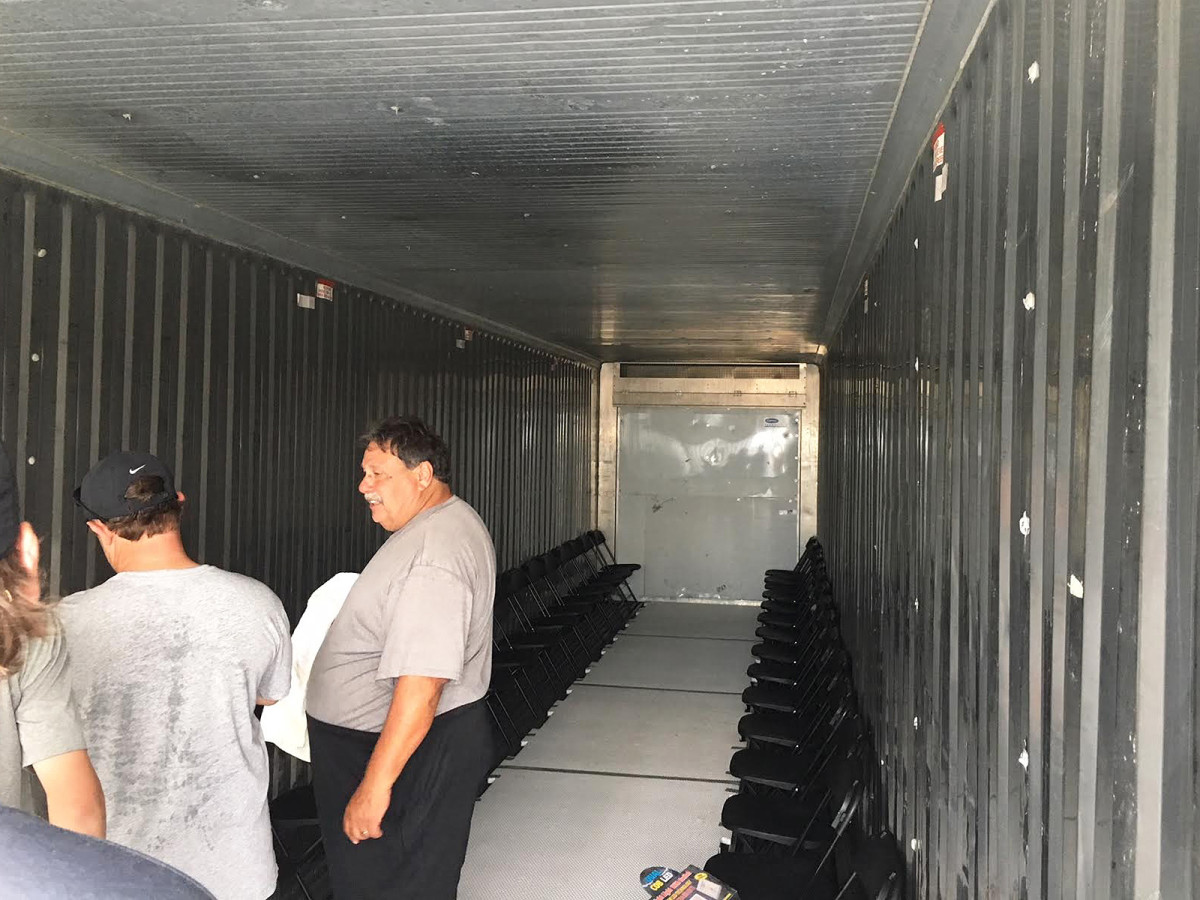
In the middle of the year’s most hectic day, Greg Stringfellow’s phone begins to quack like a duck. He removes it from his pocket to see a string of text messages from New York Jets safety Jamal Adams requesting the school send him some of his old college gear.
Stringfellow smiles as he looks up from his phone, “I’ve got to take care of my guys,” he says. As LSU football’s equipment director, Stringfellow’s responsibilities extend to alums playing professionally. Just recently, he shipped to quarterback Danny Etling, now in New England, and to running back Derrius Guice, now with the Redskins, their college-worn shoulder pads. Running back Leonard Fournette, with the Jacksonville Jaguars, still wears his college shoulder pads, the purple and gold flaps sometimes peering from beneath his jersey. “It’s a comfort deal,” Stringfellow says. “Shoulder pads get broken in and become a part of them.”
Stringfellow returns the phone to his pocket. He can’t worry about Adams’s requests right now, but he’ll get to it later. Today, on this Friday Aug. 3, is what’s known as “fitting day,” when football players stream into the now-bustling epicenter of any major college football program: the equipment room. There, LSU’s equipment staff—four full-timers and 13 student managers—fit them for new apparel and equipment a day before fall camp begins.
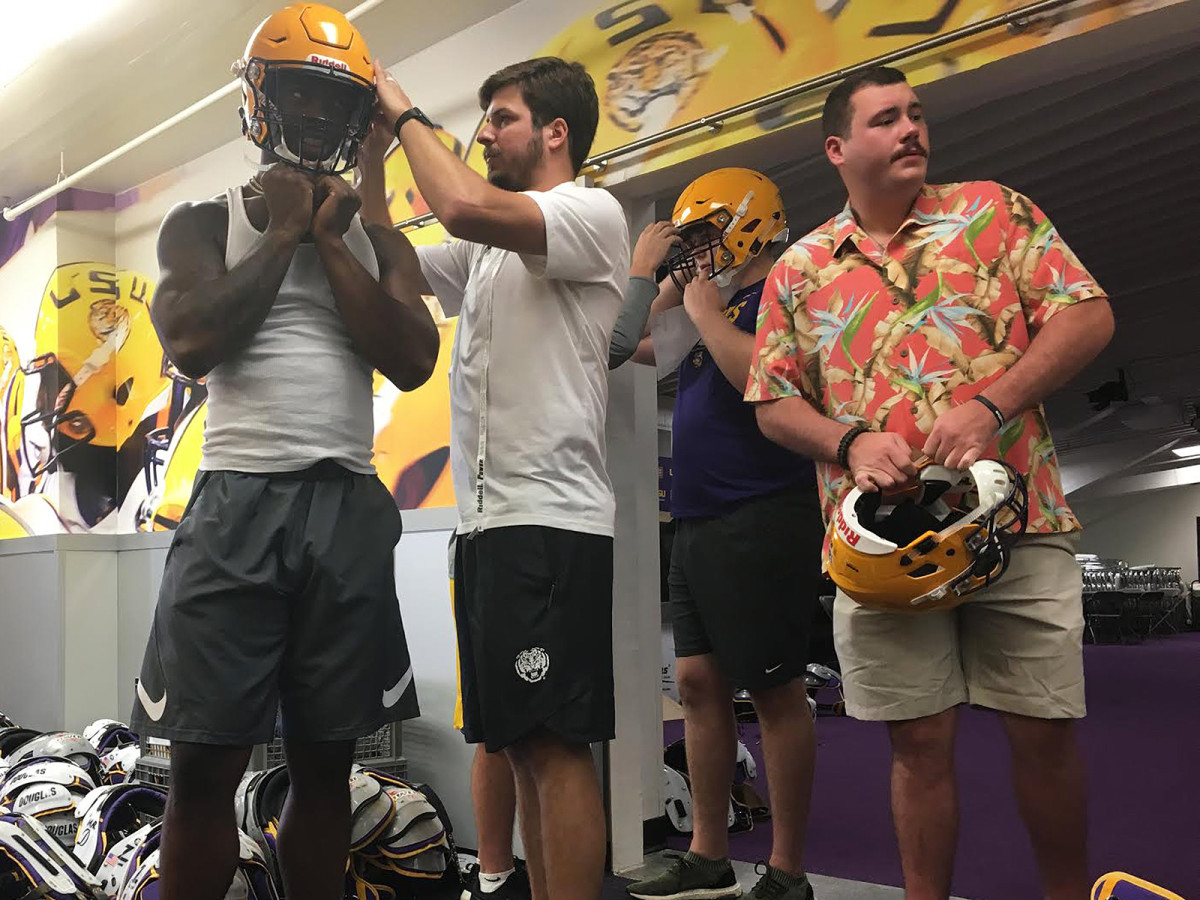
This is Stringfellow’s 27th fitting day at LSU, and he’s hurrying about in an attempt to rectify any arising problems, because there are always problems. Nothing ever goes smoothly. Take, for example, the day before, when Stringfellow’s expertise with the power drill was needed to hang that freezer door onto Boudreaux’s shipping container after attempts by others failed.
On Friday, new issues arise. A box containing shoulder pads belonging to older players has vanished, and another box of new shoulder pads, expected to arrive earlier in the week from the manufacturer, won’t arrive until Monday, the third day of camp. The staff is down two boxes of shoulder pads as players begin to show up at 7:30 a.m.
Saahdiq Charles’s precious set of shoulder pads are in the lost box. The 6-foot-5, 320-pound left tackle shoots Stringfellow a glare upon learning of this. “We’ll find’em!” Stringfellow promises the sophomore. Stringfellow’s second in command, Eric Cookmeyer, isn’t as confident. The 26-year-old from Mandeville was thrust into the No. 2 role this week, and you can tell. His hair is a bit of a mess, the result of running his hands throught it continuously. “I’m stressed about the shoulder pads,” he grumbles.
Cookmeyer followed a similar path as many equipment managers at LSU. Everyone starts as a volunteer trainee, for a year or two, before a spot opens on the student staff of 13. Each of the 13 receives some scholarship money, all based on experience, and the four head student managers are getting a full ride.
This place is like a fraternity, an institution Jeff Boss founded in 1980 and something Stringfellow continued after Boss succumbed to cancer in 2003. The annual new group of trainees is referred to by some as a “pledge class,” and each rookie gets a thick, three-ring binder labeled as an equipment manager’s handbook. The staff always includes at least one legacy manager, and this year that’s a kid they call Smurf. Chase Falterman’s father served as a student equipment manager in the 1990s. “He loved it, so I wanted to try it,” Falterman says.
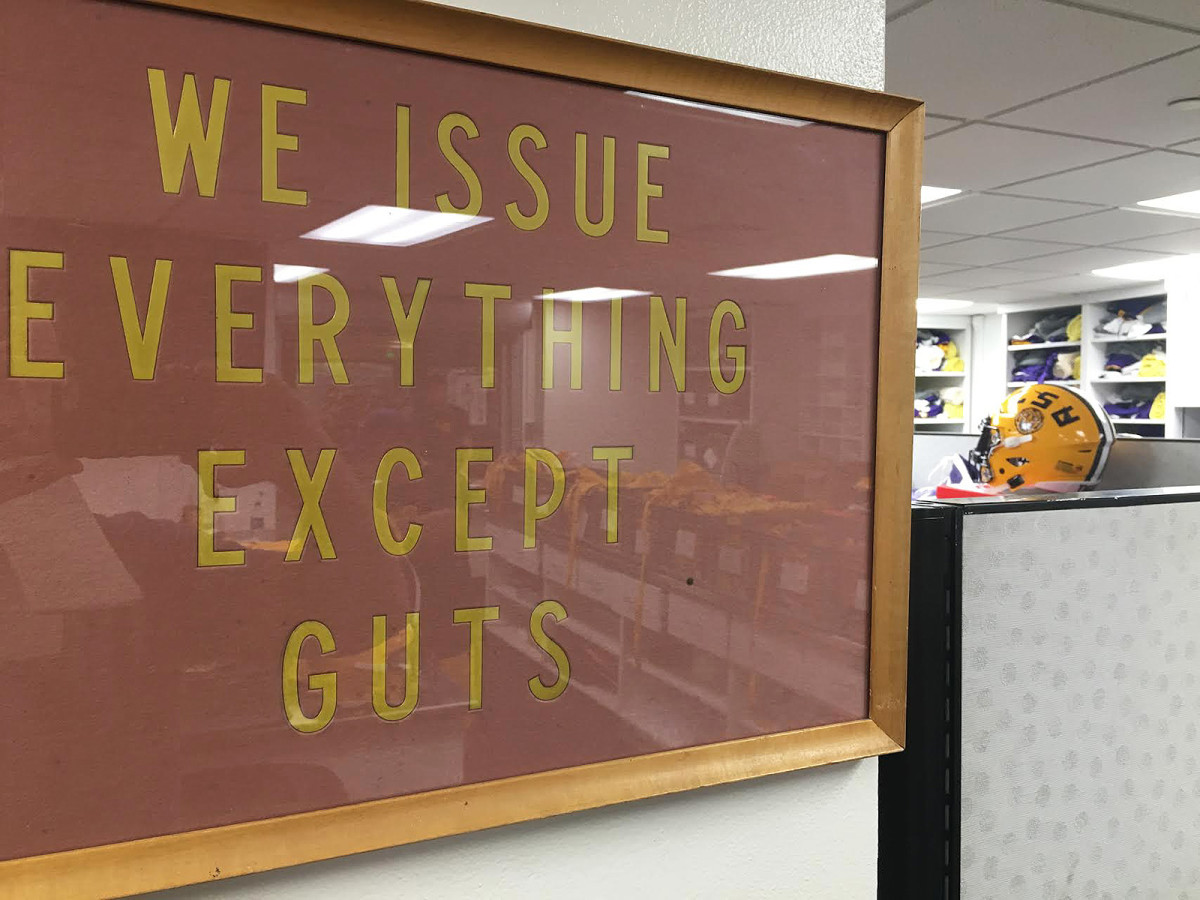
There are other nicknames among this crew: Screech, String, Mango, Blanket. On fitting day, each has a responsibility. The younger guys are assembling helmets, attaching chinstraps and facemasks to blank yellow domes. Older guys are fitting players for shoulders pads, and Trey Baskerville, in his second year as a student manager, is overseeing the most popular department: shoes.
Each player gets a package that includes five pairs of shoes: two pairs of outdoor cleats, one pair of indoor cleats, shower shoes and workout shoes. Cleats are just as important as shoulder pads to a football player. Fournette, for example, wore the same style of cleat his entire three-year career at LSU. Even when Nike stopped producing the slim, lightweight Vapor Untouchables, LSU’s staff kept enough to last through his final season. “We still have one pair of size 14s left,” Stringfellow smiles.
The shoe guy on Friday, Baskerville becomes the equipment staff’s “offensive coordinator” on the practice field, Cookmeyer says. He’s responsible for the quarterbacks and keeping track of the footballs at practice. That doesn’t seem so tough a job until you learn how many footballs are used at a given LSU practice: 150. David Jackson, one of the longtime student managers, is stationed with defensive coordinator Dave Aranda, and he’s in charge of all the headsets at practice. Kiley Greathouse, a 25-year-old from Florida with an 18-month-old son at home, is the defensive line’s equipment man, and he’s responsible for coordinating the field setup for practice along with another important job: ensuring players’ cleat laces are tied. “It’s hard for the guys wearing gloves,” he says.
These are the unsung heroes of any football program, guys who are paid little or nothing at all, fathers who spend long hours at football stadiums and in locker rooms tending to some of the country’s biggest stars. Their bond with players is like no other. LSU has two equipment rooms, one at Tiger Stadium and another at the football operations building, and they each feature a glassless window opening up to a locker room. “We see them every day. We get close to them,” says 32-year-old Matt Montgomery, one of Stringfellow’s full-timers. “We can look at them and tell if they’re in a bad mood or if something’s wrong.”
To a head coach, they’re “invaluable,” says Ed Orgeron. “They know the pulse of the team.”
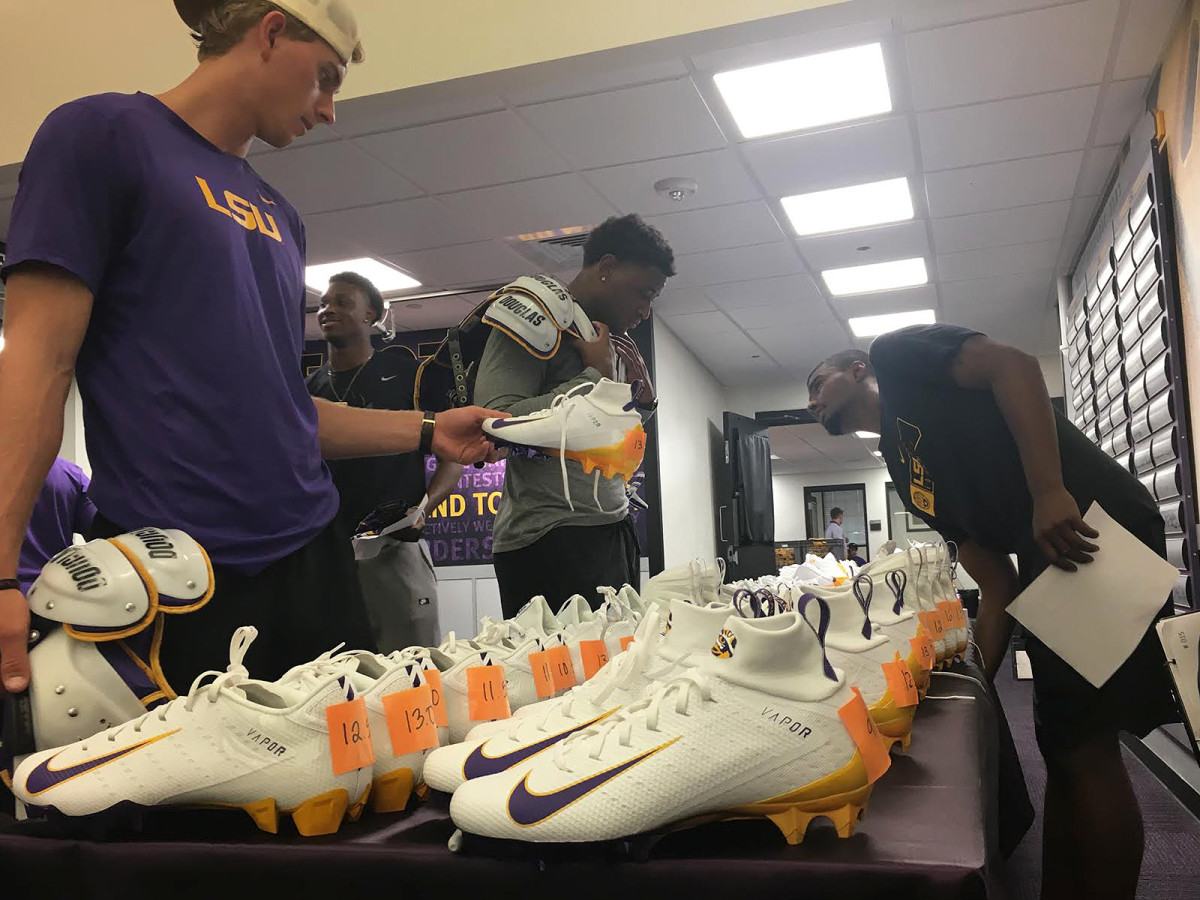
A day before camp opens in Baton Rouge, Hudson Lemoine, a local manager at Coca-Cola, has stocked LSU with 8,000 bottles of water and 1,000 bottles of Powerade. That does not include the 100 gallons of water trainers have prepared for Day 1 of camp or the 1,500 pounds of ice ready to go, too.
A player might lose as many as 12 pounds during a two-hour practice in the Louisiana heat, and so each consumes an average of two to three gallons of water a day, says Jack Marucci, LSU’s head trainer and one of the founding members of the Marucci Bat Company.
Marucci and his training staff are preparing for the start of camp across the street in LSU’s football operations building. His office is home to some of the most unique research in all of college football. For instance, Marucci and sports science researcher Nathan Lemoine led an experiment three years ago to study a player’s sweat at a given practice. The results were startling. The average player lost about 1,100 milligrams of sodium during a 30-minute portion of practice outdoors. That’s equal to four 20-ounce bottles of Powerade.
During camp, Marucci encourages players to consume 1,000 milligrams of sodium each night before bed. Water during practice is infused with liquid sodium and sodium gels, including a concoction developed by former LSU quarterback Matt Flynn called Myhy. “You just can’t drink water,” Marucci says.
Sodium-enriched Powerade is a big thing around here, too. In fact, the school recently acquired what Hudson Lemoine describes as a “freestyle Coke machine on steroids,” except it discharges Powerade. It is believed to be the first of its kind in America, and it was recently used at the World Cup in Russia, he says. The machine creates singular custom cups of Powerade, with settings that can be adjusted on a digital touchscreen. An athlete can choose his cup’s flavor and sweetness while also controlling its amount of carbohydrates, sodium, potassium and electrolytes.
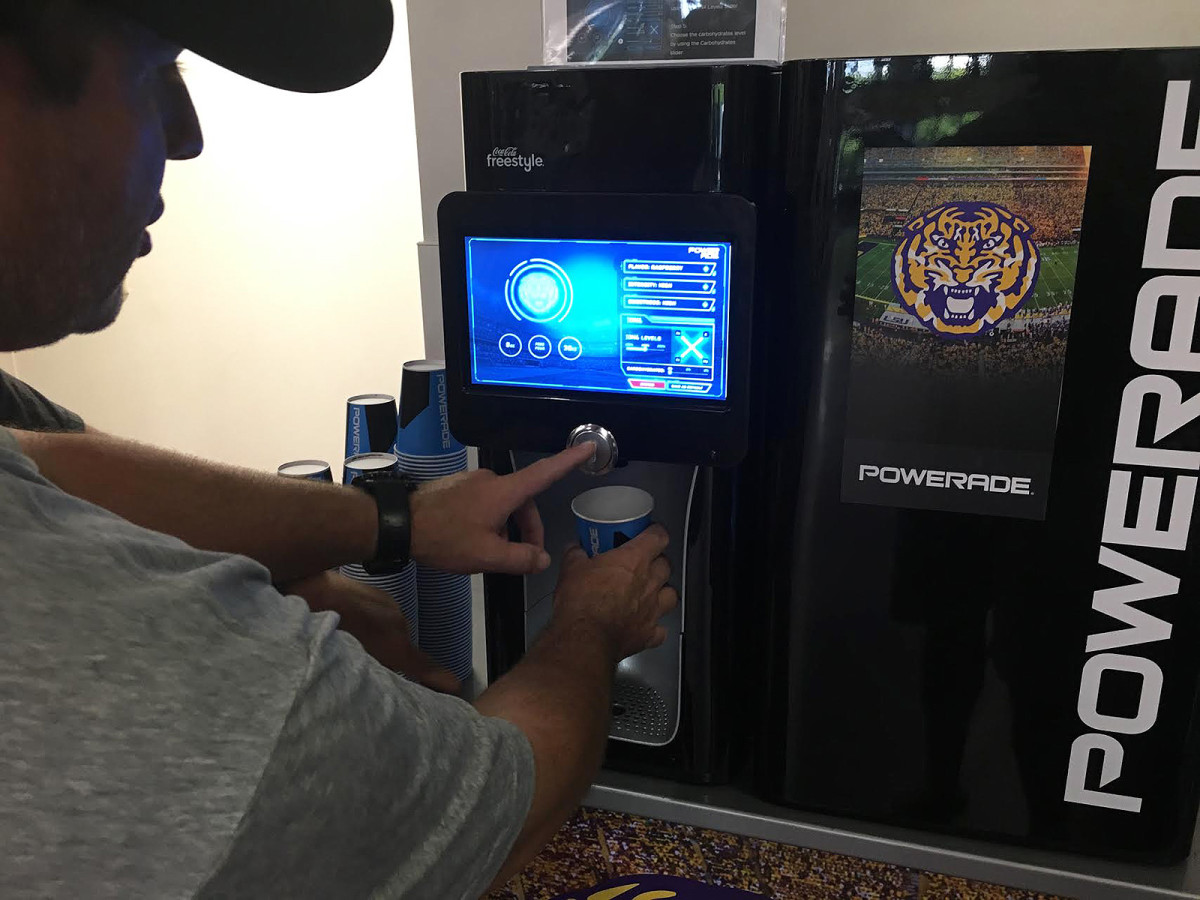
The school plans to transport the machine to the sidelines of Tiger Stadium this fall, using a $1,500 battery to keep it operating throughout the game. Marucci’s sodium-inspired research resulted in a first last season, he says: No LSU player suffered from cramps bad enough to be pulled from a game. “It was incredible,” he says.
Boudreaux’s human icebox is the newest venture, maybe the next big thing to come out of the Bayou. Five colleges and the New Orleans Saints plan to use or are using a Boudreaux icebox this August, including LSU, Alabama, South Carolina, Clemson and Louisiana at Lafayette. LSU and Alabama were seen as pilot programs last year, and Boudreaux is now expanding his new endeavor as requests roll in from across the southeast. The icebox last year lowered a player’s core temperature by full degree in just a few minutes, and “that’s a lot,” Marucci says.
LSU has tested its players mid-practice with core temperatures approaching 105 degrees. The projected high temperature in Baton Rouge in 10 of the next 14 days is at least 90 degrees with, at its lowest, a humidity prediction of 65%. Heat indexes break 105 degrees on a daily basis, and LSU’s outdoor artificial turf practice field has sizzled to as hot as 160 degrees. “The hottest part of the US is the I-10 corridor from Dallas to the east coast,” Boudreaux says. “You got that hot moisture off the Gulf.”
Through his company, Boudreaux Athletics, Boudreaux has managed sideline cooling systems for multiple Super Bowls in New Orleans, and he supplies cooling equipment to west coast teams playing September games in this area. He got out of the pipe fitting business nearly two decades ago and has taken full advantage of the south Louisiana weather. He politely declines to reveal from where he leases the shipping containers. He smiles wide. “Can’t have anybody copying me,” he says.
What to Watch for as Ohio State's Investigation Into Urban Meyer Begins in Earnest
Veteran players normally do not change shoulder pads from one season to the next, but safety Grant Delpit is an exception. Why? a student manager asks the sophomore Friday during fitting day. He points to his former set of pads, “I broke my collarbone in those.”
Football has superstitious players just like baseball. Some players wear the same set of socks for each game, the same style of shoe for multiple seasons and the same girdle for way, way too long. Student equipment staff members, fans themselves, know all of the secrets about guys who some of them used to emulate.
“They come to us for so many things,” says Taylor Higgins, a 19-year-old just recently promoted from a volunteer. “It’s crazy because you grow up as a fan and you’ve never think you’d be this close to the players.”
At 10:30 a.m. Friday, right in the middle of this bustling day, Stringfellow looks up from a table to see LSU’s talked-about quarterback transfer from Ohio State peering into the equipment room. “Joey Football!” he yells. Joe Burrow draws attention as he enters. LSU’s in-house photographer and videographer rush to his side, following him through the stations of fitting day: check-in, girdle and gloves, pants and shorts, shoes, shoulder pads and helmet.
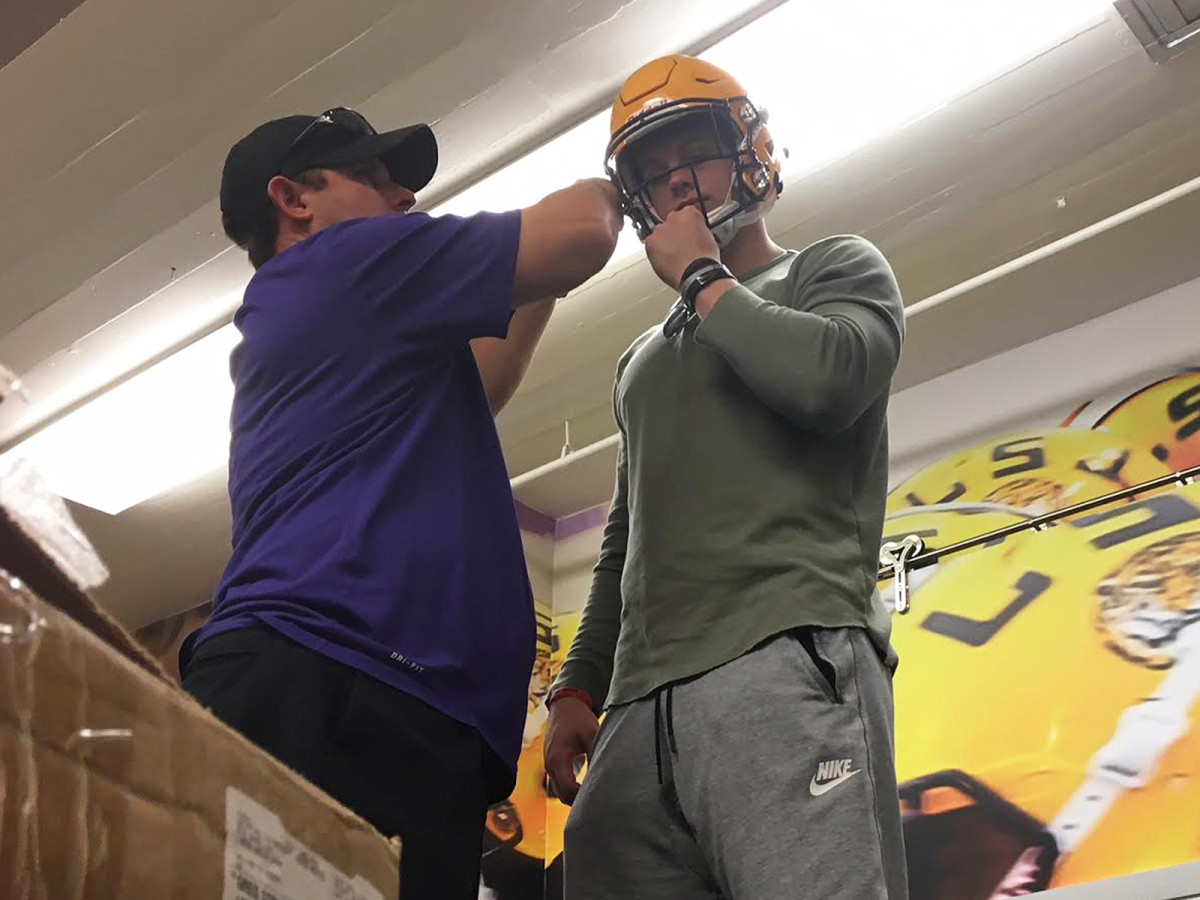
“I like the low tops,” Burrow tells Baskerville, pointing to a shoe style before picking his facemask.
“This one,” he says.
“A medium speedflex,” the manager responds.
The equipment team knows some of Burrow’s tastes and measurements because they called Ohio State for the information, a typical move for any incoming transfer and something that is replicated by other universities. Equipment staffs everywhere are full of football-loving young guys who party with one another whenever they get the chance. They hold a yearly conference in Gulf Shores at the same time as the millions-making Southeastern Conference football coaches meet an hour down the beach in Destin for their spring meetings.
“We can’t afford to stay in Destin,” Stringfellow half jokes, a good example of the pay imbalance between equipment workers and the coaches who couldn’t function without them. Stringfellow is the face of the department, a 45-year-old father of four girls, including a set of six-year-old twins. He’s been working from 7 a.m. to 7 p.m. for more than a week. “My wife hates me right now,” he chuckles.
As fitting day winds down, Stringfellow finds himself fitting a shirtless Delpit for his new shoulder pads, a seven-inch scar from collarbone surgery clearly visible across his left clavicle. Stringfellow bangs on the left side of Delpit’s shoulder pads, testing how the injury reacts to force. Does that hurt? No, Delpit says. Stringfellow bangs harder. Hurt? No, Delpit says. With balled fists, he pounds the pads once more, so hard this time that Delpit’s knees bend. Any pain? Delpit smiles and answers softly, “It’s still tender.”
K’Lavon Chaisson, a sophomore LSU hopes is the answer to replacing Arden Key as an edge rusher, is up next, and managers quickly realize he needs to go up a size in his shoulder pads because of offseason growth in his widening frame. He gets his helmet readjusted, too, and selects a new facemask, slipping on the final product and then testing it out by repeatedly slamming the crown of his helmet into a concrete wall. “Oh yeah,” he says, “we ready.”
His actions have left black streaks on a doorway to a room that media members gather for post-game interviews. Don’t you worry—soon enough, an equipment manager is sure to swing by, maybe when no one’s looking, and scrub off the unwanted marks.
The equipment guys like it this way, Montgomery says, tucked in the shadows, an afterthought among the stars of college football. “My mom watches the games and she was like, ‘I saw you on TV!’ And I’m like, ‘Crap!’” Montgomery says. “We don’t want to be seen.”
